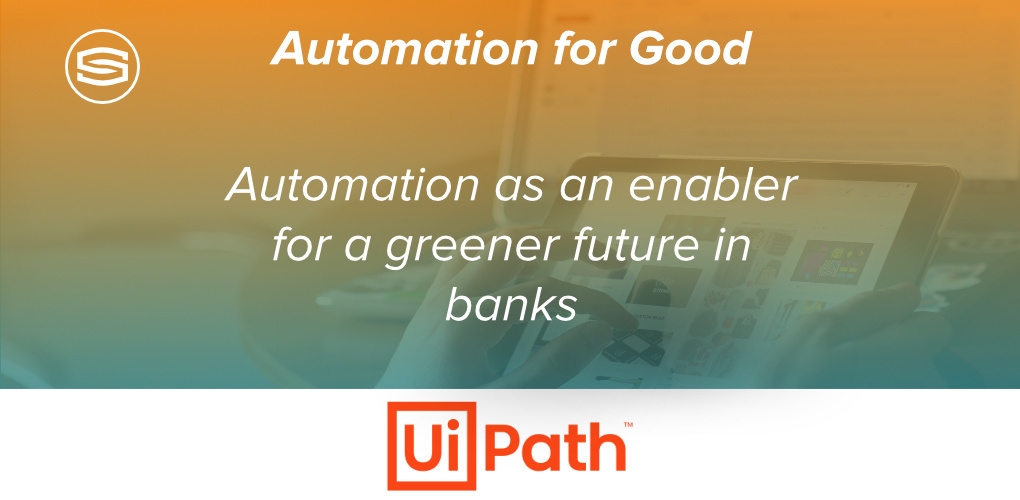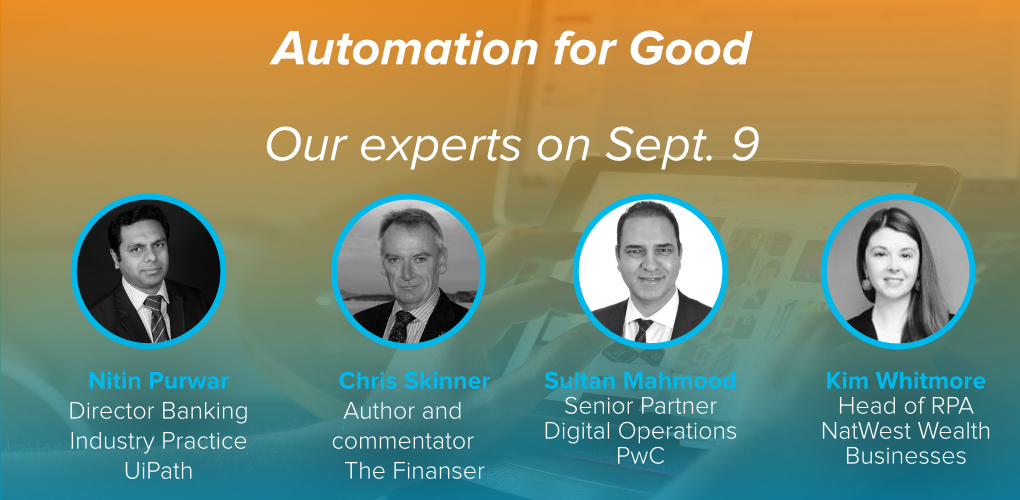
Insights & Opinions
Automation for Good - Automation as an enabler for a greener future in banks
Mon, 13 Sep 2021


Purely looking at ESG and sustainability from a regulatory point of view would be a serious mistake and an underestimation of the importance of both topics. In a world that pivots increasingly more to stakeholdership, banks hear equally important messages from customers, investors and society, in general, to dedicate more resources and attention to topics like ESG and sustainability.
How can banks anticipate rapidly to these messages? As Chris Skinner, one of the most influential voices in technology and financial services, said: "It's not just talking the talk. It's actually committing to walk the walk."
Chris Skinner was one of the panellists and was joined by:
- Kim Whitmore, Head of RPA, NatWest Wealth Businesses
- Nitin Purwar, Director Banking Industry Practice at UiPath
- Sultan Mahmood, Senior Partner Digital Operations, PwC

Everyone will agree that automation can be used as an enabler for ESG and sustainability in banks, but what are the concrete use cases? We looked at how automation can help banks contribute to a greener future and how automation makes happy employees and happy customers. We even discussed how automation could create a more inclusive digital banking world.
In this blog, we look closer at the key message of this session in relation to a greener future. A second blog will follow soon on how automation contributes to a "better conservation of people and relationships."
By the way: the recordings of the entire session can be viewed here.
Time to walk the walk
We know for decades that humankind is destroying its environment, and yet, just recently, the message for a greener future got mainstream. Society asks everyone to take responsibility, and banks are in the middle of these discussions.
"I always go back to Lord Adair Turner's comments in 2009. Then he was the chairman of the Financial Services Authority, the main UK regulator. He questioned banks about their moral compass. And whether they were socially useful or useless", explained Chris.
"What's happening today is, and it's taken a long time to get there, is that corporations and financial institutions are starting to change their ways because of activist consumers and investors. They are telling them to deliver environmental responsibility, societal responsibility, do good for the planet and good for society, and have better corporate governance, and a moral compass to be socially useful."
Banks must act, and they must act fast.
Automation as a tactical solution for a greener future
With an endless list of priorities, banks often look for tactical solutions first to examine the long-term strategic questions later. Automation has valuable assets to help banks at this tactical level.
Mahmood: "That's where the beauty of automation and digitisation comes in because you're not building your complex long-term solutions. You're building things that can be modified, upgraded and changed over time as well, to give you those sort of important ESG KPIs."
The most speaking example of automation being a tactical solution for the greener future is bridging data across standards in the bank's new regulatory requirements. Financial institutions are forced to measure and report their commitments, but the data to build those reports come from different internal and external silos.
RPA can help align these different standards, not by changing the formats but by combining different formats in an understandable way.
"One of the things being reported is the consumption of natural resources as part of a bank's corporate real estate", said Nitin. "Now imagine a bank like NatWest, that alone operates in 15 countries. They have many different offices across each of these countries. How do you make sure that you properly measure your natural resources consumption across all these locations, across all the offices?"
This is just one example of how automation can help.
Also, in going the extra mile, automation can help. Kim shared an excellent example in that respect: "We engaged with some of the projects and programs taking place. Not everyone is aware of the capabilities of RPA. We help them investigating if there is anything we can do to bring forward some of their deliverables with a more tactical solution, even if they've got more strategic plans coming down the road."
In the prioritisation process, they match the requested changes with the purpose that NatWest has put forward, and climate change is very important in that respect, as well as human well-being (more on that later).
As an example of a quick change with a significant impact, Kim shared the project of automating the process for sending out statements to third parties.
Kim: "We made a straightforward automation robot that goes into the system that creates the statements, downloads them, sends them in an email, very quick to do. It got prioritised straight away because we've included that in our new prioritisation process and delivered it within four weeks." They automated the process before the next monthly run was due, and the process became paperless.
Automation as a strategic solution for a greener future
As a valuable partner of UiPath, PwC follows closely how automation can help banks. As the pandemic made homeworking the new normal, there was a big drive to the cloud, explained Sultan.
"We saw an opportunity to help clients to move to the cloud. So we created a tool that allows banks to assess their current infrastructure footprint, their data centre footprint and work out what are the commercial benefits of moving potentially all of that to the cloud, to give them a more scalable infrastructure."
To Sultan's surprise, banks were interested in understanding what it would mean for their ecological footprint to shift to cloud services or from one provider to the other. So suddenly, the PwC calculations through automation became a valuable asset for banks in their strategic decision process on the future of their IT infrastructure.
Conclusion
There is a global consensus today that every person, every organisation and every institution has their role to play and their responsibility to take. Everything starts with setting a baseline. For financial institutions that wish to help build a greener future, the first step is measurement and reporting of what they accomplish today as a starting point to do better in the future.
Like NatWest, banks should not limit their efforts to regulatory requirements but also investigate how automation can contribute to tactical solutions to help banks reduce their ecological footprint, like paper reduction in administrative processes.
A sustainable and greener future is only part of the ESG agenda. We discussed a lot more, and that will follow in a second blog later this month when we discuss how automation solutions can contribute to a healthier work environment and sometimes helped banks build more inclusive digital banking.
P.S.: if you like more on this topic, have a look at the interview we did with Nitin Purwar.
P.P.S.: as I said in the beginning of this article: the recordings of the entire session can be viewed here.



